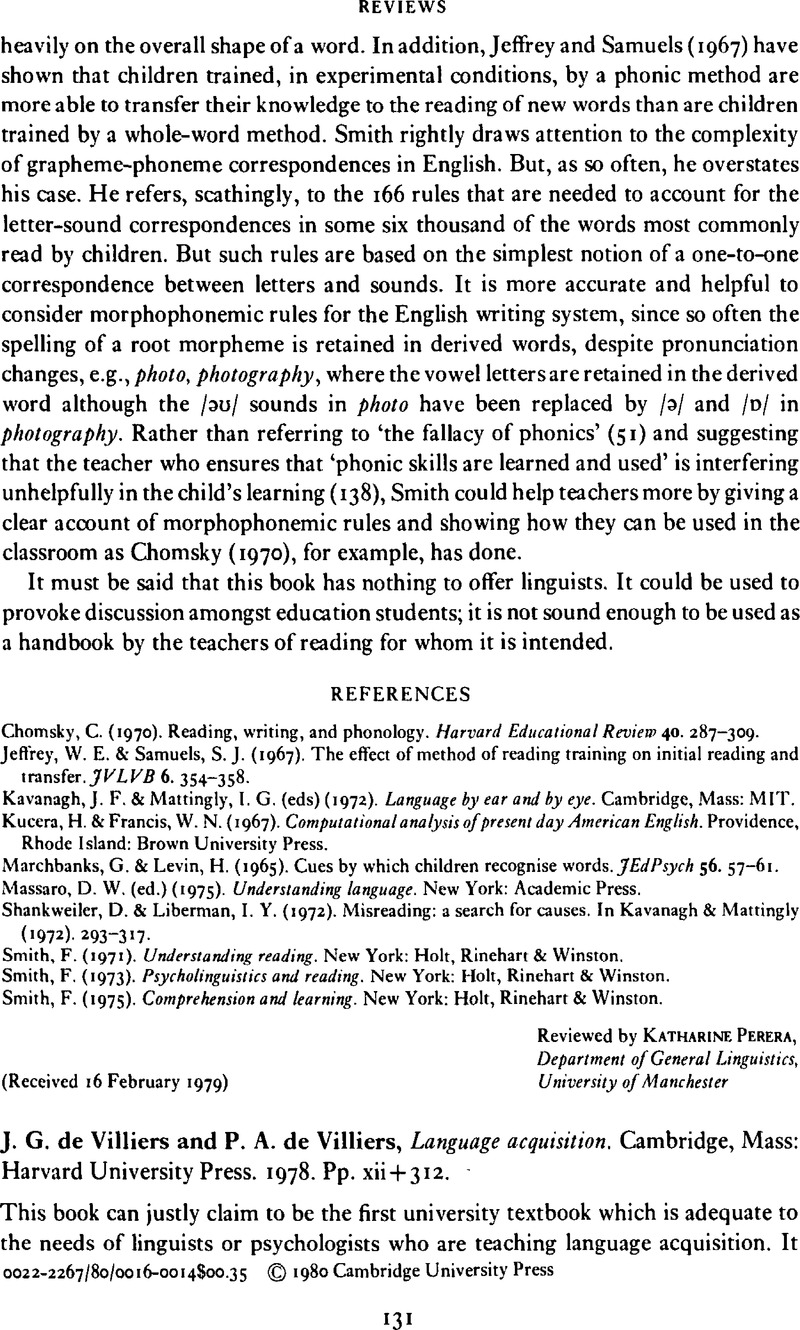No CrossRef data available.
Article contents
J. G. de Villiers and P. A. de Villiers, Language acquisition. Cambridge, Mass: Harvard University Press. 1978. Pp. xii+312.
Review products
J. G. de Villiers and P. A. de Villiers, Language acquisition. Cambridge, Mass: Harvard University Press. 1978. Pp. xii+312.
Published online by Cambridge University Press: 28 November 2008
Abstract
An abstract is not available for this content so a preview has been provided. Please use the Get access link above for information on how to access this content.

- Type
- Reviews
- Information
- Copyright
- Copyright © Cambridge University Press 1980
References
REFERENCES
Bever, T. G. (1970). The cognitive basis for linguistic structures. In Hayes, J. R. (ed), Cognition and the development of language. New York: Wiley.Google Scholar
Brown, R. (1973). A first language: the early stages. Cambridge, Mass.: Harvard University Press.CrossRefGoogle Scholar
Brown, R. & Hanlon, C. (1970). Derivational complexity and order of acquisition in child language. In Hayes, J. R. (ed.), Cognition and the development of language. New York: Wiley.Google Scholar
Carney, E. (forthcoming). Inappropriate abstraction in speech assessment procedures. Brit. Jnl. Dis. Comm.Google Scholar
Chomsky, C. (1969). The acquisition of syntax in children from 5–10. Cambridge, Mass: M.I.T. Press.Google Scholar
Ferguson, C. A. (1973). Fricatives in child language acquisition. Papers and Reports on Child Lang. Devel. 6. 61–85.Google Scholar
Ferguson, C. A. & Farwell, C. (1975). Words and sounds in early language acquisition: English consonants in the first fifty words. Lg 51. 419–439.Google Scholar
Fodor, J. A., Bever, T. G. & Garrett, M. (1974). The psychology of language. New York: McGraw-Hill.Google Scholar
Jakobson, R., Fant, G. & Halle, M. (1952). Preliminaries to speech analysis. Technical Report 13, M.I.T. Acoustics Laboratory. Cambridge, Mass: M.I.T. Press.Google Scholar
Macken, M. A. (1977). Developmental reorganization of phonology: a hierarchy of basic units of acquisition. Papers and Reports on Child Lang. Devel. 14. 1–36.Google Scholar
Macken, M. A. & Barton, D. (1977). A longitudinal study of the acquisition of the voicing contrast in American-English word-initial stops, as measured by voice-onset time. Papers and Reports on Child Lang. Devel. 14. 74–120.Google Scholar
Menyuk, P. (1968). The role of distinctive features in children's acquisition of phonology. JSHR 11. 138–146.CrossRefGoogle ScholarPubMed
Premack, D. (1976). Intelligence in ape and man. Hillsdale, N.J.: Lawrence Erlbaum Associates.Google Scholar
Rosch, E. & Mervis, C. G. (1975). Family resemblances: studies in the internal structure of categories. Cognitive Psychol. 7. 573–605.CrossRefGoogle Scholar
Rosenbaum, P. S. (1967). The grammar of English predicate complement constructions. Cambridge, Mass: M.I.T. Press.Google Scholar
Smith, N. V. (1973). The acquisition of phonology: a case study. Cambridge: Cambridge University Press.Google Scholar


